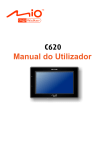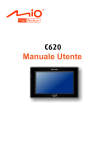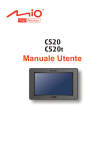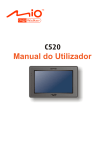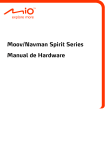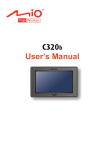Download Mio C620 GPS Receiver User Manual
Transcript
User’s Manual This manual contains mostly hardware information. To know how to use the software of your device, please refer to the other manual. R02 (EU) Trademarks The Bluetooth word mark and logo are owned by the Bluetooth SIG, Inc. All other brand and product names are trademarks or registered trademarks of their respective companies. Disclaimer Specifications and manuals are subject to change without notice. Mio Technology assumes no liability for damage incurred directly or indirectly from errors, omissions, or discrepancies between the device and the manuals. Table of Contents Precautions and Notices .......................................................................iii 1 Getting Started..................................................................................1 1.1 1.2 1.3 1.4 1.5 1.6 2 Understanding Hardware Components................................................ 1 Front Components ............................................................................... 1 Back Components................................................................................ 2 Left-Side Components ......................................................................... 2 Top Components.................................................................................. 3 Bottom Components ............................................................................ 3 Performing the Initial Start Up .............................................................. 4 Charging the Battery via the USB Cable.............................................. 5 Using Your Device in a Vehicle............................................................ 6 Using the Device Cradle or TMC Cradle.............................................. 6 Connecting the Car Charger ................................................................ 7 Operating Basics .................................................................................. 8 Turning On and Off .............................................................................. 8 Navigating on the Screen..................................................................... 8 Main Menu............................................................................................ 9 Inserting a SD/SDHC/MMC Card....................................................... 10 MioStudio ........................................................................................11 2.1 2.2 2.3 2.4 2.5 2.6 2.7 About MioStudio ................................................................................. 11 Using MioStudio ................................................................................. 11 Installing MioStudio ............................................................................ 11 Staring and Exiting MioStudio ............................................................ 12 MioStudio Screen Elements............................................................... 13 MioStudio Settings ............................................................................. 14 Help and Support ............................................................................... 14 MioNet ................................................................................................ 15 MioClub .............................................................................................. 16 Map Recovery .................................................................................... 17 Update................................................................................................ 18 MioTransfer ........................................................................................ 19 i 2.8 Outlook Sync ...................................................................................... 21 2.9 Speed Camera ................................................................................... 21 2.10 Image Search ..................................................................................... 21 3 Troubleshooting and Maintenance ...............................................25 3.1 3.2 3.3 4 Regulatory Information ..................................................................29 4.1 4.2 ii Restart and Shut Down ...................................................................... 25 Restarting Your Device ...................................................................... 25 Shutting Down Your Device ............................................................... 25 Troubleshooting ................................................................................. 26 Power Problems ................................................................................. 26 Screen Problems................................................................................ 26 Connection Problems......................................................................... 27 GPS Problems.................................................................................... 27 Maintaining Your Device .................................................................... 28 Regulations Statements ..................................................................... 29 European Notice ................................................................................ 29 Bluetooth ............................................................................................ 30 Safety Precautions ............................................................................. 30 About Charging .................................................................................. 30 About the Charger.............................................................................. 30 About the Battery ............................................................................... 31 Precautions and Notices z For your own safety, do not operate the controls of the product while driving. z Use this product prudently. The product is intended for use solely as a navigation aid. It is not for precise measurement of direction, distance, location or topography. z The calculated route is for reference only. It is the user’s responsibility to follow the traffic signs and local regulations along the roads. z When you get out of the car, do not leave your device on the dashboard subjected to direct sunlight. Overheating of the battery can cause malfunction and/or danger. z GPS is operated by the United States government, which is solely responsible for the performance of GPS. Any change to the GPS system can affect the accuracy of all GPS equipments. z GPS satellite signals cannot pass through solid materials (except glass). When you are inside a tunnel or building, GPS positioning is not available. z A minimum of 4 GPS satellite signals is needed to determine current GPS position. Signal reception can be affected by situations such as bad weather or dense overhead obstacles (e.g. trees and tall buildings). z Other wireless devices in the vehicle might interfere with the reception of satellite signals and cause the reception to be unstable. iii z A car holder is needed when using the device in a car. Be sure that you place the device in an appropriate place, so as not to obstruct the driver’s view, or deployment of airbags. Do not mount where the driver’s field of vision is blocked. Do not mount in front of airbag panels. iv Do not place unsecured on the dashboard. Do not mount in front of an airbag field of deployment. 1 Getting Started 1.1 Understanding Hardware Components NOTE: Depending upon the specific model purchased, the color of your device may not exactly match the device shown in this manual. Front Components Ref n Component Touch Screen o Charge p Indicator Microphone Description Displays the output of your device. Tap the screen with your fingertip to select menu commands or enter information. Glows bright amber to indicate that the battery is charging, and turns green when the battery is fully charged. For Bluetooth hands-free calling. 1 Back Components Ref Component Description n External GPS This connector (under rubber dust cover) allows use of an Antenna Connector o Speaker optional external GPS antenna with magnetic mount, which may be positioned on top of the car for better signal reception in areas with poor reception. Sends out music, sounds and voice. Left-Side Components 2 Ref Component n SD/SDHC/MMC Slot o Headphone Connector Description Accepts a SD (Secure Digital), SDHC (Secure Digital High Capacity), or MMC (MultiMediaCard) card for accessing data such as MP3 music. Connects to stereo headphones. Top Components Ref Component n Power Button Description Turns on and off the device. (Pressing briefly or for a long duration makes a difference. See sections 1.5 and 3.1 for information.) Bottom Components Ref Component Description n Mini-USB Connector Connects to the charger or USB cable. o Cradle Connector Connects to the cradle. (The cradle supplied with your device depends on the model you purchased.) 3 1.2 Performing the Initial Start Up 1. For the initial start up, press the power button for 5 seconds to turn on your device. NOTE: For normal operation, briefly press the power button to turn on and off your device. 2. Your device turns on. Immediately charge your device as described in the next section. 3. When the language selection screen appears, select the desired language. 4. The Main menu appears. You can now use your device. 4 1.3 Charging the Battery via the USB Cable 1. Turn on the computer. 2. Connect the mini-USB end of the USB cable to the bottom of your device and the other end to a USB port on your computer. 3. If your device is on, the screen as shown below appears. Whenever your device is connected to a computer, you will not be able to use it. 4. The charge indicator glows amber when charging is in progress. Do not disconnect your device from AC power until the battery is fully charged, the charge indicator will turn green. This will take a couple of hours. 5 NOTE: z When the device is connected to a computer, it is recognized as an external mass storage device. Do not delete any files pre-installed in the device. Deleting files of which the function is unknown can cause programs or features to malfunction. z If you intend to charge your device in this way, turn off your device so that it takes less time to charge the battery. CAUTION: For optimal performance of the lithium battery: z Do not charge the battery where the temperature is high (e.g. in direct sunlight). z There is no need to fully discharge the battery before charging. You can charge the battery before it is discharged. z When storing the product for a long period of time, be sure to fully charge the battery at least once every two weeks. Over discharge of the battery can affect the charging performance. 1.4 Using Your Device in a Vehicle CAUTION: z Select an appropriate location for mounting the device in a vehicle. Never place the device where the driver’s field of vision is blocked. Make sure that the GPS antenna has a clear view of the sky. z If the car’s windshield is tinted with a reflective coating, an external antenna (optional) may be needed to route the antenna to the top of the vehicle through a window. When closing the window, be careful not to pinch the antenna cable. Using the Device Cradle or TMC Cradle Depending on the model you purchased, a device cradle or a TMC cradle is supplied. Use the cradle and the stand to fix your device in a vehicle. (See a separate document for the installation instruction.) With the TMC cradle (for select models only), you can connect the TMC antenna to receive radio transmissions that are used to inform drivers of traffic conditions. TMC information is monitored by the navigation software. Once the information is received, you can view it on your device and traffic icons will appear in the map view. Certain roads with reported traffic will be highlighted and you can choose to avoid those roads and an alternate route will be automatically calculated. (See the navigation software manual for detailed information.) 6 Connecting the Car Charger The car charger supplies power to your device when you are using the device in a car. CAUTION: To protect your device against sudden surges in current, connect the car charger only after the car engine has been started. 1. Connect one end of the car charger to the power connector of the cradle. 2. Connect the other end to the cigarette lighter in the car to power and charge your device. The indicator on the car charger lights in green to indicate that power is being supplied to your device. 7 1.5 Operating Basics Turning On and Off For normal operation, turn off the device by briefly pressing the power button. The device enters a suspended state. When you next briefly press the power button, the system resumes. You will be back to where you left off. NOTE: Pressing the power button for a longer duration has a different effect. See section 3.1 for more information. Navigating on the Screen To operate your device, touch the screen with your fingertip. You can perform the following actions: z 8 Tap Touch the screen once with your fingertip to open items or select onscreen buttons or options. z Drag Hold your fingertip on the screen and drag up/down/left/right or across the screen. z Tap and hold Tap and hold your fingertip until an action is complete, or a result or menu is shown. Main Menu The first time you initialize your device, the Main menu appears with the Find tab selected. From the Main menu, you can select another tab by tapping a button on the right side of the screen. A total of five tabs are available. n o p q r No. Button Name Description n Map Switches to the Map screen. o Find Opens the Find screen where you can search and select a place as your destination. Opens the Route screen where you can manage your route. p Route q Tools r Settings Opens the Tools screen where you can access functions such as audio player, contacts, picture viewer, calendar, and Bluetooth phone connection. Opens the Settings screen where you can customize the system settings. For instructions on using the software, see the other manual supplied with your device. 9 1.6 Inserting a SD/SDHC/MMC Card Your device has a slot where you can insert an optional SD/SDHC/MMC storage card. To use a card, insert it into the slot, with the connector pointing to the slot and its label facing the front of the device. To remove a card, first make sure that no application is accessing the card, then slightly push the top edge of the card to release it and pull it out of the slot. NOTE: Make sure that no foreign objects enter the slot. 10 2 MioStudio 2.1 About MioStudio MioStudio is a collection of management tools. With the various tools, you can: z Access the official website of Mio Technology z Access the Mio Club registration website and log in as a member z Restore the navigation software and map data to the factory default state z Check the Mio server for any updates and execute the updates z Transfer multimedia files between your device and computer z Synchronize Outlook data (such as Contacts and Calendar) between your device and computer z Import speed camera database to your device z Search images from an online photo sharing website 2.2 Using MioStudio Installing MioStudio 1. Turn on your computer and insert the supplied DVD into the DVD-ROM drive of your computer. 2. When the language selecting screen appears, click the language that you wish to install from. 3. Click Install MioStudio. NOTE: Do not terminate the installation process. Unexpected termination will result in incomplete installation. 11 4. Follow the onscreen instructions to complete the installation. Some independent program(s) will be installed together with MioStudio. Staring and Exiting MioStudio NOTE: z Some MioStudio tools require your computer to be connected to Internet. z Most MioStudio tools require your device to be connected to the computer via the USB cable. z Disconnect the USB cable only after exiting MioStudio. Before disconnecting the cable, you must click the device icon in the task bar and click “Safely remove xxx” (where xxx is the name of your device). If you are transferring data, disconnecting the cable without following the correct removal procedure can result in data loss. To start MioStudio, either click the MioStudio shortcut on the Windows desktop or select the program from the Start Æ ProgramsÆMio Technology menu. The small icon appears in the system tray. To open the MioStudio window, double click this icon. To close the window and leave the program running in the background, click the X button at the top right corner. To exit the program, click File Æ Exit if the MioStudio window is open or right click the icon in the system tray and click Exit. 12 MioStudio Screen Elements n p o The MioStudio screen consists of three major parts: z On the top of the screen is the menu bar (n). z On the left side of the screens are the tool buttons (o). Each tool represents an independent module. z On the right is the display area (p) for the specific tool selected. See later sections for descriptions of all the tools. 13 MioStudio Settings To change how MioStudio works, click Tools Æ Options if the MioStudio window is open or right click the icon in the system tray and click Options. Two tabs are available. z General This page allows you to enable or disable the automatic check for update (enabling means the check will be performed periodically when MioStudio has been started), enable or disable the automatic startup of the program, and switch to a different language for the program. z Advance This page allows you to select a different folder for downloaded files. Help and Support When the MioStudio window is open, you can click Help Æ Support to access the Mio support website. 14 2.3 MioNet NOTE: Make sure that your computer is connected to Internet. Clicking the MioNet button displays the company’s official website in the embedded browser window. You can then browse the web pages in the window. Use the buttons on top of the window to go back and forth and go to the Home page. 15 2.4 MioClub NOTE: Make sure that your computer is connected to Internet. Clicking the MioClub button displays the Mio Club registration website in the embedded browser window. You can then create your Mio Club account. After registration, you’ll have access to data and software updates. 16 2.5 Map Recovery Use the Map Recovery tool if you need to restore your navigation software and map data to the factory default state. 1. Click the Map Recovery button. 2. Insert the DVD supplied with your device to your computer. 3. Connect your device to your computer via the USB cable. 4. Click Start. 5. Follow the onscreen instructions to continue. 17 2.6 Update NOTE: z This Update tool does not provide the update of the navigation software and map data. z Make sure that your computer is connected to Internet. The Update tool searches the Mio server for the below updates: z Program update for your MioStudio z Firmware (or called ROM image) update for your device if your device has been connected to your computer Update is performed once whenever MioStudio is started, the device is connected, or the Update button is clicked. In addition, update is performed periodically if the Auto Check for Update function is enabled (as described in “MioStudio Settings” in section 2.2). When a new update is detected, a popup window appears to remind you. The search results will be listed in the Update tool. To perform the update: 1. Connect your device to your computer via the USB cable. 2. Click the Update button. 18 In the display area, the “Local Computer” panel on the left displays the search result and the “Mio Device” panel on the right displays the ROM image version of your device. NOTE: When you point an update item with the mouse cursor, a small window pops up and stays for a few seconds, showing brief information of the item. 3. Click the check box to select the update item to install and click Install. 2.7 MioTransfer Before playing multimedia files such as MP3 files with your device, you need to have the files ready on your device. Use the MioTransfer tool to copy the files from your computer to the correct location on your device. 1. Connect your device to your computer via the USB cable. 2. To transfer files, click the MioTransfer button. Two panels appear in the display area: “Local Computer” on the left and “Mio Device” on the right. 3. On the top of the display area are three tabs (Audio, Video, and Picture). Click a tab to transfer the selected type of files to the correct location on your device. Depending on the model you purchased, not all three tabs are available to you. 19 4. The display area shows the folders and filenames as Windows File Explorer does in the Details view. To copy a file or file(s) to your device, select the source file(s) from the left panel and then drag it to the right panel. 5. From the popup menu, click Copy or Move. NOTE: z Most operations available in Windows File Explorer are available in MioTransfer, such as right clicking and sorting, while irrelevant operations will not be supported by MioTransfer. z You can adjust the width of each column by dragging the vertical line between the columns. 20 2.8 Outlook Sync NOTE: Outlook Sync is a program installed separately. In case it has not been successfully installed or has been accidentally removed, you can manually install the program by running the OutlookSyncSetup.msi program located in the install\MioStudio\ folder on the DVD. on the DVD. To synchronize Outlook data between your device and computer, click the Outlook Sync button. This launches the Outlook synchronization tool. For instructions on using the tool, see the other manual supplied with your device. 2.9 Speed Camera NOTE: Speed Camera is a program installed separately. In case it has not been successfully installed or has been accidentally removed, you can manually install the program by running the SpeedCAMSetup.exe program located in the install\MioStudio\ folder on the DVD. You can download the latest speed camera database from the Mio server and import the data to your device. 1. Make sure that your computer is connected to Internet. 2. Connect your device to your computer via the USB cable. 3. Click the Speed Camera button. This launches the Speed Camera tool. 4. Follow the onscreen instructions to complete the operation. 2.10 Image Search MioStudio incorporates the image keyword search function powered by Flickr. It allows you to easily get the photos you want by searching among a huge database of shared photos. 1. Make sure that your computer is connected to Internet. 2. Click the Image Search button. 3. Enter your keywords in the “Search for” field. 21 4. If you want to sort the photos, select an option from the “Sort by” pull-down menu: z None z Most interesting This will sort the images by their interesting levels. Interesting levels are determined by Flickr through the use of a complex algorithm. z Most relevant This is the default setting. It will sort the images by those that most closely match your keywords. 5. After entering the keywords and making necessary choices, click Search. NOTE: If you want to stop the search, click Stop. 6. The matching photos will appear in the display area. The bottom of the screen provides the page information and a Back and a Next button for going to the previous and next page. 7. To download a photo, right click the photo. To download multiple photos at one time, first select them and then right click the mouse. 8. Click one of the two options from the shortcut menu as described below: 22 z Import to MioDevice This saves the downloaded photo(s) to the your device. Make sure that your device is connected to your computer via the USB cable. z Save As This allows you to select a folder in your computer for the downloaded photo(s). 23 3 Troubleshooting and Troubleshooting and Maintenance Maintenance 3.1 Restart and Shut Down Occasionally, you may need to reset your device. For example, you should reset your system when it stops responding; or appears to be “frozen” or “locked up.” Restarting Your Device To restart your device, press the power button for 5 seconds until the “Power Off Selection” screen appears and then tap Restart. Shutting Down Your Device To shut down your device, press the power button for 5 seconds until the “Power Off Selection” screen appears and then tap Shutdown. Alternatively, you can press the power button for 10 seconds to directly shut down the device. This is useful when a software failure prevents the “Power Off Selection” screen from displaying. 25 Shutting down puts the device in a deep sleep state. The device will close all running programs before shutting down. To use the device again, press the power button for 5 seconds. 3.2 Troubleshooting NOTE: If you encounter a problem you cannot solve, contact an authorized service center for assistance. Power Problems Power does not turn on when using battery power z The remaining battery power may be too low to run your device. Charge the battery. Screen Problems Screen responds slowly z Make sure that your device is not running out of battery power. If the problem still exists, reset your system. Screen freezes z Reset your system. Screen is hard to read z Make sure that the backlight of the display is on. z Move to a location with more light. Inaccurate response to taps z 26 Recalibrate the touch screen. Connection Problems Cable Connection Problems z Make sure that your device and your computer are both turned on before trying to establish a connection. z Make sure that the cable is securely plugged into the USB port on your computer and on the device. Connect the USB cable directly to your computer—do not run the cable through a USB hub. z Reset your device before connecting the cable. Always disconnect your device before you restart your computer. GPS Problems When there are no valid signals available, consider the following: z Make sure that the device is facing a clear view of the sky. z Note that the GPS reception can be affected by: 9 Bad weather 9 Dense overhead obstacles (e.g. trees and tall buildings) 9 Other wireless device in the car 9 Reflective car window tint and heated screens. 27 3.3 Maintaining Your Device Taking good care of your device will ensure trouble-free operation and reduce the risk of damage to your device. z Keep your device away from excessive moisture and extreme temperatures. z Avoid exposing your device to direct sunlight or strong ultraviolet light for extended periods of time. z Do not place anything on top of your device or drop objects on your device. z Do not drop your device or subject it to severe shock. z Do not subject your device to sudden and severe temperature changes. This could cause moisture condensation inside the unit, which could damage your device. In the event of moisture condensation, allow the device to dry out completely before use. z Take care not to sit on the device. We advise not to carry the device in one’s back pocket for that reason. z The screen surface can easily be scratched. Avoid touching it with sharp objects. Non-adhesive generic screen protectors designed specifically for use on portable devices with LCD panels may be used to help protect the screen from minor scratches. z Never clean your device with it powered on. Use a soft, lint-free cloth moistened with water to wipe the screen and the exterior of your device. z Do not use paper towels to clean the screen. z Never attempt to disassemble, repair or make any modifications to your device. Disassembly, modification or any attempt at repair could cause damage to your device and even bodily injury or property damage and will void any warranty. z Do not store or carry flammable liquids, gases or explosive materials in the same compartment as your device, its parts or accessories. 28 4 Regulatory Information NOTE: Marking labels located on the exterior of your device indicate the regulations that your model complies with. Please check the marking labels on your device and refer to the corresponding statements in this chapter. Some notices apply to specific models only. 4.1 Regulations Statements European Notice Products with the CE marking comply with Radio & Telecommunication Terminal Equipment Directive (R&TTE) (1999/5/EEC), the Electromagnetic Compatibility Directive (89/336/EEC) and the Low Voltage Directive (73/23/EEC) – as amended by Directive 93/68/ECC - issued by the Commission of the European Community. Compliance with these directives implies conformity to the following European Standards: EN301489-1: Electronic compatibility and Radio spectrum Matters (ERM), ElectroMagnetic Compatibility (EMC) standard for radio equipment and services; Part 1: Common technical requirements EN301489-17: Electronic compatibility and Radio spectrum Matters (ERM), ElectroMagnetic Compatibility (EMC) standard for radio equipment and services; Part 17: Specific conditions for 2,4 GHz wideband transmission systems and 5 GHz high performance RLAN equipment EN55022: Radio disturbance characteristics EN55024: Immunity characteristics EN6100-3-2: Limits for harmonic current emissions EN6100-3-3: Limitation of voltage fluctuation and flicker in low-voltage supply system EN60950 / IEC 60950: Product Safety EN 300 328 (Bluetooth): Electromagnetic compatibility and Radio spectrum Matters (ERM); Wideband Transmission systems; Data transmission equipment operating in the 2,4 GHz ISM band and using spread spectrum modulation 29 techniques; Harmonized EN covering essential requirements under article 3.2 of the R&TTE Directive The manufacturer cannot be held responsible for modifications made by the User and the consequences thereof, which may alter the conformity of the product with the CE Marking. Bluetooth Bluetooth QD ID B012565 4.2 Safety Precautions z Prolonged listening of music in maximum volume can damage the ears. z The use of headphones other than those recommended/supplied can cause hearing impairment due to excessive sound pressure. About Charging z Use only the charger supplied with your device. Use of another type will result in malfunction and/or danger. z This product is intended to be supplied by a LISTED Power Unit marked with “LPS”, “Limited Power Source” and output rated + 5 V dc / 1.0 A”. z Use a specified charger approved by the manufacturer. About the Charger z Do not use the adapter in a high moisture environment. Never touch the adapter when your hands or feet are wet. z Allow adequate ventilation around the adapter when using it to operate the device or charge the battery. Do not cover the charger with paper or other objects that will reduce cooling. Do not use the charger while it is inside a carrying case. z Connect the adapter to a proper power source. The voltage requirements are found on the product case and/or packaging. 30 z Do not use the adapter if the cord becomes damaged. z Do not attempt to service the unit. There are no serviceable parts inside. Replace the unit if it is damaged or exposed to excess moisture. About the Battery z Use a specified battery in the equipment. CAUTION: This unit contains a non-replaceable internal Lithium Ion battery. The battery can burst or explode, releasing hazardous chemicals. To reduce the risk of fire or burns, do not disassemble, crush, puncture, or dispose of in fire or water. z Important instructions (for service personnel only) 9 Caution: Risk of explosion if battery is replaced by an incorrect type. Dispose of used batteries according to the instructions. 9 Replace only with the same or equivalent type recommended by the manufacturer. 9 The battery must be recycled or disposed of properly. 9 Use the battery only in the specified equipment. 31







































